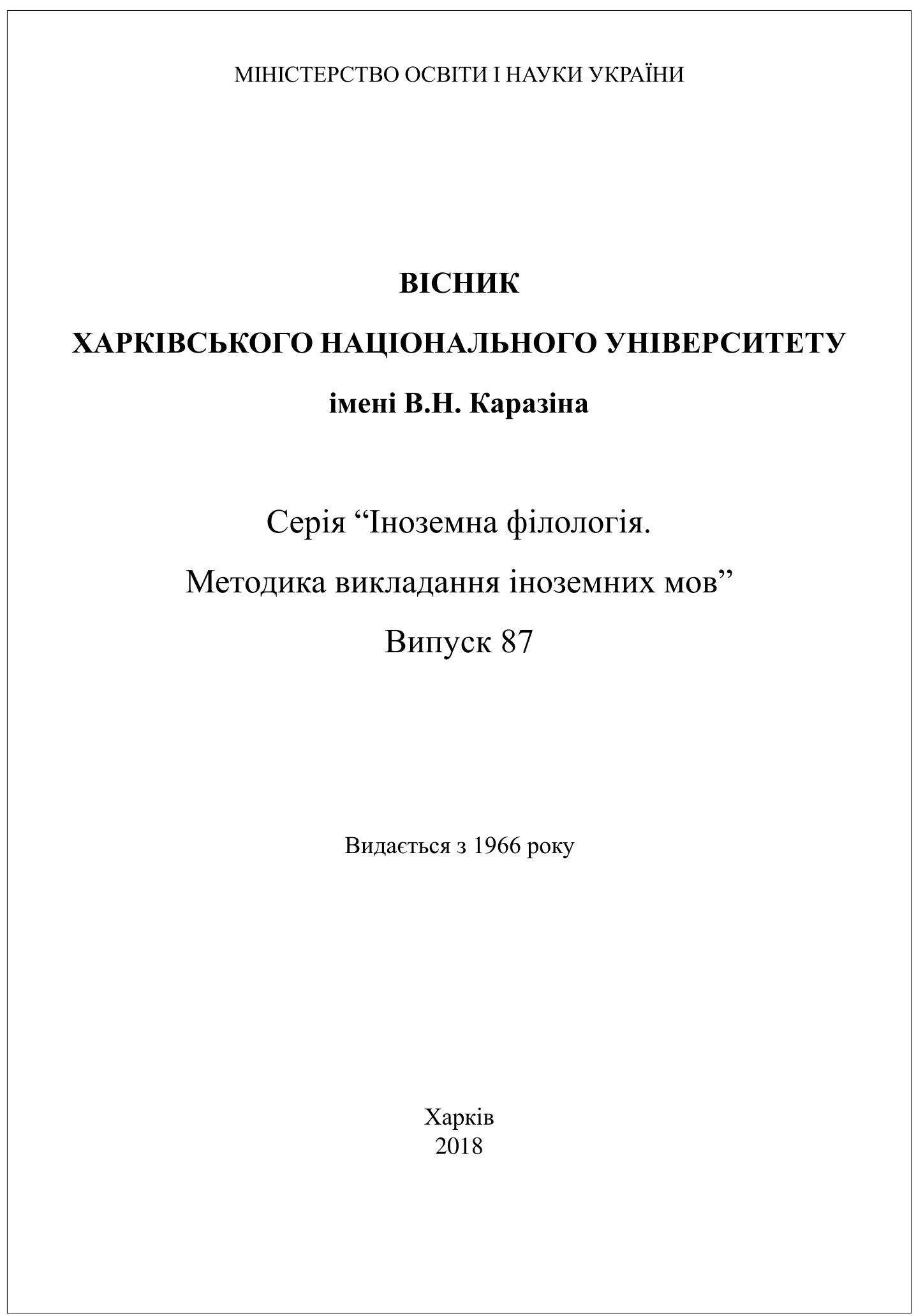Сміх як миттєва респонсивна комунікативна дія реципієнтів англомовних ідеаційних промов
Анотація
Стаття присвячена дослідженню респонсивних комунікативних дій реципієнтів англомовних ідеаційних промов, які проявляються як сміх. Англомовна ідеаційна промова є структурованим й обмеженим часовими рамками усним мовленням ідеатора, укупі з мультимодальними комунікативно значущими діями, що відбуваються перед аудиторією (реципієнтами), безпосередньо або опосередковано включеною в комунікацію: тобто такою, що знаходиться в одних і тих самих часово-просторових координатах з ідеатором (безпосередньо у студії, де ідеатор виступає наживо) або в різних часово-просторових координатах (перегляд записаного виступу ідеатора). Ідеаційні промови спрямовані на донесення до реципієнтів певних ідей задля втілення їх в соціальну практику. Респонсивні дії реципієнтів поділяються на миттєві та відстрочені. Відстрочені респонсивні дії є імпліцитно-оцінними (кількість переглядів відеоролику ідеаційної промови) або експліцитно-оцінними (розгорнуті письмові оцінки промов у вигляді коментарів та згорнуті оцінки шляхом вибору оцінних прикметників із числа пропонованих). Миттєві респонсивні дії включають спонтанні, ініційовані самими реципієнтами, та неспонтанні, ініційовані ідеатором. Спонтанні миттєві респонсивні дії проявляються як сміх, вигуки, оплески, які свідчать про комунікативну успішність промови, сприйняття ідеатора та його ідеї. Дослідження респонсивних дій реципієнтів дає можливість визначити успішність чи неуспішність певної ініціальної комунікативної стратегії ідеатора. Сміх аудиторії свідчить про вдалість комунікативного ходу ідеатора для зміни тональності з серйозної на гумористичну. У сміхові проявляється сприйняття та розуміння аудиторією смислу жарту. У деяких випадках сміх є виразом різних емоційних реакцій реципієнтів, як, наприклад, здивування, відраза, захват тощо.
Завантаження
Посилання
Aleshyn, S. (1974, March 14). Smeh mozhet vse [Laughter can do everything]. Literaturnaya gazeta, p. 8.
Anderson, C. (2016). TED Talks. The Official TED Guide to Public Speaking. Houghton Mifflin Harcout. Boston, New York: Mariner.
Attardo, S., and Raskin, V. (1991). Script Theory Revis(it)ed: Joke Similarity and Joke Representation Model. Humor: International Journal of Humor Research, 4(3/4), 293–348.
Bahtin, M.M. (1979). Estetika slovesnogo tvorchestva [Aesthetics of word art]. Moscow: Iskusstvo Publ.
Bahtin, M.M. (1986). Literaturno-kriticheskie statyi [Literary-critical articles]. Moscow: Hudozhestvennaya literature Publ.
Bilyk, A.M. (1992). Komicheskiy smeh [Comic laughter]. Visnyk Kharkiv. nats. un-tu im. V.N. Karazina. – V.N. Karazin Kharkiv National Univ. Messenger, 373, 27–33 (in Russian).
Bondarenko, E.V., Martynyuk, A.P., Frolova, I.E., Shevchenko, I.S. (2017). Kak narisovat portret ptitsy: metodologiya kognitivno-kommunikativnogo analiza yazyka [How to paint a picture of a bird: methodology of cognitive-communicative analysis of language]. Kharkiv: KhNU imeni V.N. Karazina Publ.
Borev, Yu.B. (2002) Smeh: istoki i funktsii [Laughter: sources and functions]. St. Petersburg: Nauka Publ.
Dementyev, V.V. (1998). Sotsiopragmaticheskiy aspect teorii rechevyh zhanrov [Socio-pragmatical aspect of speech genres theory]. Saratov: Saratov Pedagogical Institute Publ.
Graham, D., and Bachmann, T.T. (2004). Ideation: The birth and death of ideas. Hoboken, NJ: John Wiley & Sons.
Gusserl, E. (2001). Logicheskie issledovaniya [Logic research]. Moscow: Dom intellektualnoy knigi Publ.
Koestler, A. (1964). The act of creation. NewYork: The Macmillan Company.
Makarov, M.L. (2003). Osnovy teorii diskursa [Discourse Theory Basics]. Moscow: ITDGK Gnozis Publ.
Martynyuk, A. (2008). Nesootvetstvie norme kak istochnik smehovogo effekta v tekste angloyazychnogo anekdota [Incongruity of norm as a source for laughter effect in English anecdote]. Zapysky z romano-hermansloyi filolohiyi. – Notes on Romance and Germanic philology, 20, 80–90 (in Russian).
Martynyuk, A. (2016). The Art of Metaphoric Political Insult within the Cognitive Framework. In: E. Chrzanowska-Kluczewska, and O. Vorobyova (eds.). Language – Literature – the Arts: A Cognitive-Semiotic Interface. Frankfurt am Main; Bern: Peter Lang Edition, pp. 245–261.
McGhee, P. E. (1972). On the cognitive origins of incongruity humour: fantasy assimilation versus reality assimilation. In: J.H. Goldstein, P.E. McGhee (eds.). The psychology of humour. N.Y.: Academic Press, pp. 61–80.
Minskiy, М. (1988). Ostroumie i logika kollektivnogo bessoznatelnogo [Wit and logic of collective unconscious]. Novoe v zarubezhnoy lingvistike. – New developments in foreign linguistics, 23, 281–309 (in Russian).
Raskin, V. (1985). Semantic mechanisms of humour. Dordrecht-Boston-Lancaster: D. Reidel.
Samokhina, V.O. (2012). Zhart u suchasnomu komunikatyvnomy prostori Velykoyi Brytaniyi ta SShA [Joke in contemporary communicative space of the Great Britain and the USA]. Kharkiv: KhNU imeni V.N. Karazina Publ.
Skidanova, V.A. (2005). Humor u folklorniy tvorchosti ukrayianskoho narodu [Humour in the folk art of Ukrainian people]. Doksa. Zbirnyk naukovykh prats z filolohiyi ta filosophiyi. – Doksa. Collection of scientific papers on philology and philosophy, 7, 111–118 (in Ukrainian).
Suls, J. (1972). A Two-stage Model for the Appreciation of Jokes and Cartoons: An Information Processing Analysis. In: J.H. Goldstein, and P.E. McGhee (eds.). The Psychology of Humor: Theoretical Perspectives and Empirical Issues. New York: Academic Press, pp. 81–100.
TED: Ideas worth spreading (n.d.). Available at: https://www.ted.com
Vygotskiy, L.S. (1999). Myishlenie i rech [Thinking and speech]. Moscow: Labirint Publ.




